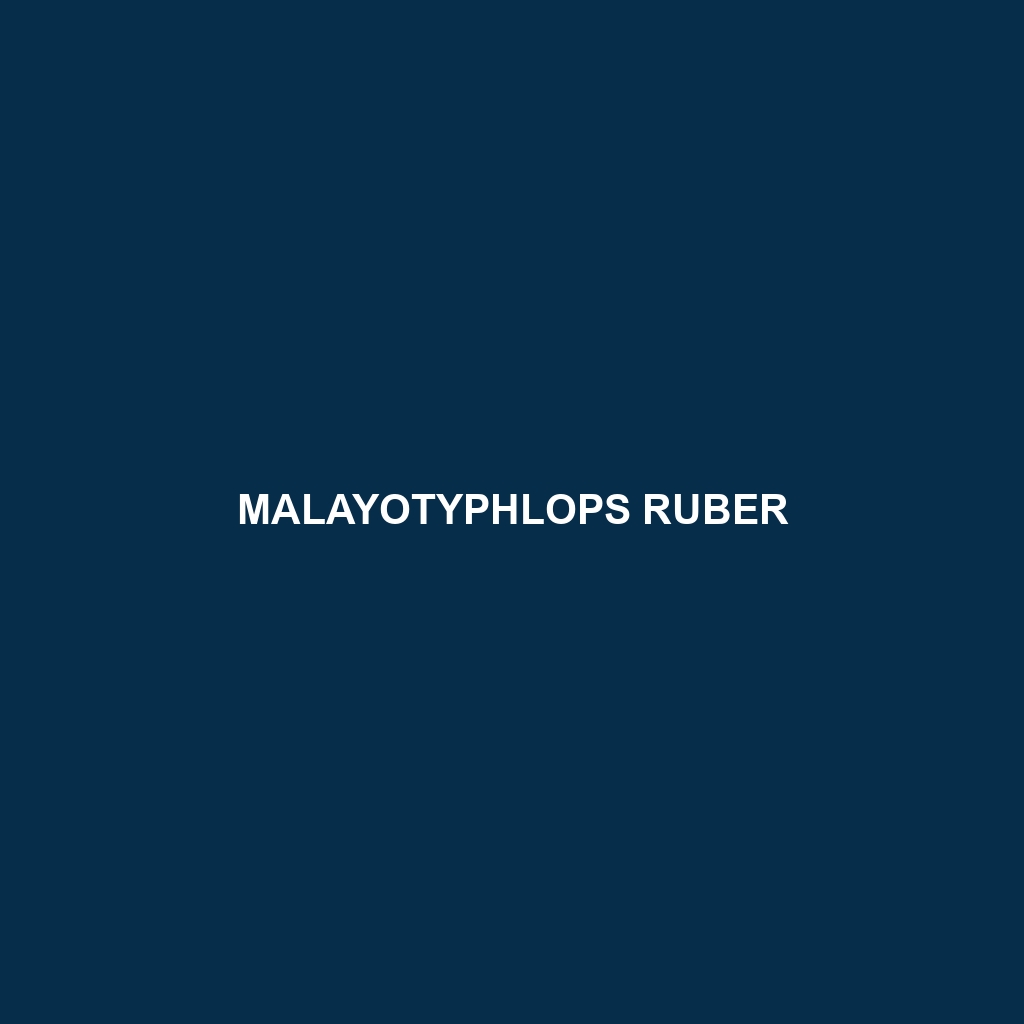Common Name
Malayotyphlops ruber
Scientific Name
Malayotyphlops ruber
Habitat
Malayotyphlops ruber, commonly known as the red-blind snake or Malayotyphlops, typically inhabits regions rich in organic matter and moisture. This species is primarily found in the tropical rainforests of Southeast Asia, particularly in countries such as Malaysia, Indonesia, and Thailand. These habitats provide the appropriate humidity and temperature ranges essential for their survival. Malayotyphlops ruber prefers the leaf litter and soft soil in these environments where they can burrow and hide from predators. They are also occasionally found in tropical savannas and temperate forests, demonstrating a level of adaptability to less humid conditions.
Physical Characteristics
Malayotyphlops ruber is a slender, elongated snake, which can reach lengths of up to 60 cm (24 inches). Its most distinguishing feature is its bright reddish-brown coloration, which aids in camouflage among the forest floor litter. The skin of this species is smooth and shiny, reflecting sunlight and providing a degree of protection from predators. Unlike many other snakes, the blind snake possesses vestigial eyes that are hardly visible, contributing to its name. Its small head is not easily distinguishable from its body, and its tapered shape is conducive to burrowing. These physical attributes make Malayotyphlops ruber highly specialized for a fossorial, or underground-focused, lifestyle.
Behavior
Malayotyphlops ruber exhibits a largely solitary lifestyle, typical of many snake species. This species is primarily nocturnal, which means it is most active during the night. Holed in the dark, moist environment, they engage in foraging for food and searching for potential mates. During the daytime, they burrow deeper into the soil, seeking refuge from the heat and potential predators. The mating season occurs during the wetter months, with males engaging in cryptic displays to attract females. These displays may include gentle rubbing against one another to relay pheromones and assess each other’s suitability as mates. Such mating rituals highlight the unique social dynamics within the species.
Diet
Malayotyphlops ruber is classified as an insectivore, primarily feeding on small invertebrates. This includes ants, termites, and various other soft-bodied insects that inhabit the leaf litter where they reside. They use their specialized, pointed snouts to burrow through the soil and leaf litter, locating and consuming their prey. Their method of feeding primarily consists of slowly probing the ground and swallowing their food whole, much like other snake species. This diet plays a crucial role in controlling the populations of the insects they consume, thus contributing to the overall balance of their ecosystem.
Reproduction
The reproductive cycle of Malayotyphlops ruber typically occurs during the rainy season, aligning with the increased availability of nutrients in their habitat. Females lay eggs, usually depositing around 6 to 10 eggs in a hidden nest within the leaf litter or underground. The incubation period lasts around two to three months, after which the young hatchlings emerge, fully formed and capable of independent survival. Interestingly, parental care is absent in this species, as young snakes must fend for themselves immediately after hatching. This reproductive strategy reflects the adaptation of the species to their environment, ensuring that the successor generation can thrive without resource competition from adults.
Conservation Status
Currently, Malayotyphlops ruber is classified as Least Concern according to the IUCN Red List. However, various threats loiter around its habitat, including deforestation, habitat degradation, and pesticide use in agriculture, which can affect their food supply. Conservation efforts are essential to monitor their populations, especially in areas experiencing deforestation or land conversion for agriculture. Continuing education about the importance of maintaining healthy ecosystems is crucial for ensuring the survival of this unique species.
Interesting Facts
Malayotyphlops ruber has several intriguing traits that might captivate enthusiasts. One notable adaptation is its ability to thrive in low-light environments, thanks to its highly developed sensory scales which are designed for detecting vibrations and movements in their surroundings. Unlike many snakes, Malayotyphlops ruber does not possess a conventional sense of sight, relying instead on its other sensory modalities. Additionally, the unique coloration of the snake not only aids in camouflage but may also serve as a warning to potential predators about its unpalatable nature.
Role in Ecosystem
Malayotyphlops ruber plays a vital role in its ecosystem as both a predator and prey. By preying on insect populations, it helps maintain ecological balance and health in its habitat. Furthermore, as a food source for larger predators, such as birds of prey and small mammals, Malayotyphlops ruber contributes to the complex food web that supports biodiversity. Its presence indicates a healthy ecosystem, as it often serves as a bioindicator reflecting the overall health and stability of the environment in which it resides.
